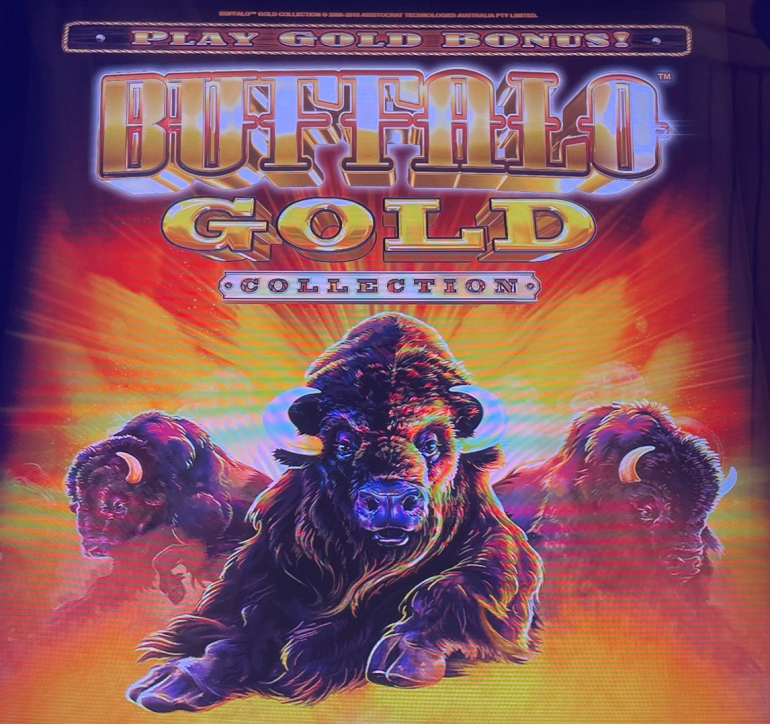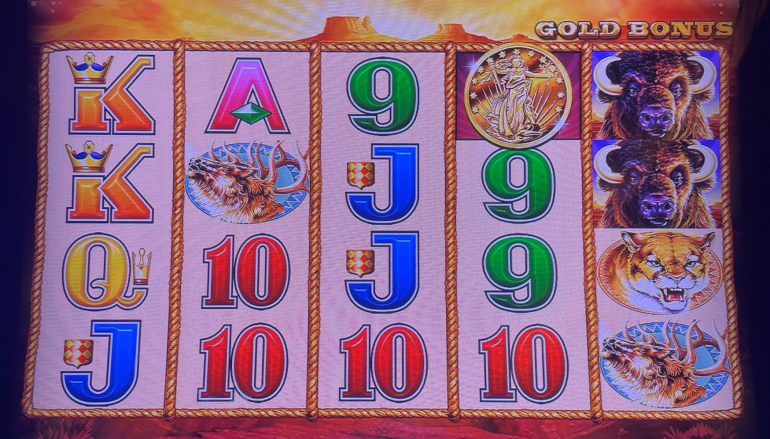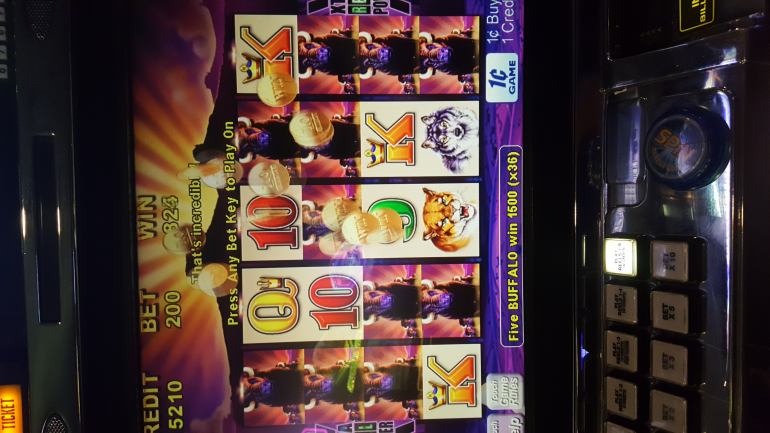Thread Rating:
Poll
 | 3 votes (27.27%) | ||
 | 5 votes (45.45%) | ||
 | 2 votes (18.18%) | ||
| No votes (0%) | |||
 | 1 vote (9.09%) | ||
 | 1 vote (9.09%) | ||
 | 1 vote (9.09%) | ||
 | 2 votes (18.18%) | ||
| No votes (0%) | |||
 | 2 votes (18.18%) |
11 members have voted
I've always wondered why the game is so popular, so I finally sat down and played it for about 15 today. Here is the gist of the game:
- The game is a "ways to win" game, as opposed to paylines.
- There are wilds on reels 2 to 4 only. In initial spins they sometimes have a multiplier of 2x or 3x.
- Wins are based on a 40 credit bet. There is also, at the Red Rock at least, a mandatory 20 credit fee to enable the bonus feature.
- The player triggers the bonus bet getting at least three scattered coins.
- 3, 4 or 5 coins trigger 8, 15, or 20 free games, respectively.
- In free games, wilds always get a multiplier of 2x or 3x.
- In free games, there are special gold buffalo symbols.
- If a reel stops on a gold buffalo it will change to a regular buffalo and remain that way the rest of the bonus.
- A counter will keep track of how many gold buffaloes the player has collected.
- If the player collects 4 gold buffaloes, then all eagle symbols on the reels turn into buffalos.
- If the player collects 7 gold buffaloes, then all cougar symbols on the reels turn into buffalos.
- If the player collects 13 gold buffaloes, then all wolf symbols on the reels turn into buffalos.
- If the player collects 15 gold buffaloes, then all elk symbols on the reels turn into buffalos.
- Free spins have coins and thus can earn more free spins. In addition, two coins earn five more free spins.
In this video, the player plays a bonus with 129 total free spins, almost $16,000 total win, and lasts 28 minutes. I did not fair so well. I played through about four bonuses but never won much in them.
Question -- The rule screens make it seem the player has the choice to:
A: Enable less than all five reels.
B: Not enable the bonus feature.
However, the machines at the Red Rock didn't you a choice. The least you could bet was 60 cents and you could multiply that by 2 to 6 if you wanted. The question is whether there are other machines that do give the player the choice on A and B above.
I would be interested in any thoughts of slot players about why they like the game and whether there is anything lacking in my game description.
The question for the poll is do you play Buffalo Gold?


Quote: Wizard
Question -- The rule screens make it seem the player has the choice to:
A: Enable less than all five reels.
B: Not enable the bonus feature.
However, the machines at the Red Rock didn't you a choice. The least you could bet was 60 cents and you could multiply that by 2 to 6 if you wanted. The question is whether there are other machines that do give the player the choice on A and B above.
link to original post
"Enable less than all five reels" is misleading.
On the other Aristocrat titles I have seen with this option, it means to partially disable reels, from right to left.
On a partially disabled reel, only one position is payable, instead of the full reel height.
Five of a kind patterns are still possible, but less likely.
Given the nature of the Buffalo Gold series, with stacked buffalo symbols and multiplier wilds being so valuable, I would not care to play without all reels fully enabled.
I think Red Rock probably made the right decision to not allow these options.
And... if I encounter these options in the wild, I'll try to let you know.
edit: This was a mechanical button deck (not touchscreen); the switches were in place for disabling the reels, but the inserts were absent and the functions disabled.
Quote: rsactuarySo how would one go about modelling the bonus feature?
link to original post
I would do it by random simulation. I would take samplings from bonuses on the hit frequency of each symbol and make up my own reel strips from that.
You could do it in such a fashion where you determine how many expected Free Games (and Gold symbols) are added on a per spin basis and I once used that to figure out the expected return for an unusual Keno game (I can find and link the LCB article if you want), but that would take forever and likely be inexact.
The reason why you would eventually stop (as I did with the Keno game) is because you end up adding very small fractions of a Free Game, one step at a time, to your analysis. The maximum number of Free Games for this Keno game was capped, but it would have taken probably a few thousand or million steps before ever reaching the cap.
Basically, what I did was figured out the expectation ($$$) per spin and then I figured out the Expected Free Games added per draw. I took that and multiplied by the initial number of Free Games in a particular set of Free Games to get the expected number of Free Games added per initial set.
After that, I took the Expected Number of Free Games added per initial set of Free Games and multiplied by how many Expected Free Games would be added based on the Expected Number of Free Games already added.
And, then I repeated the step in the previous paragraph several more times until I got to a stupidly low expected amount added and decided that was good enough.
Apparently, the RTP is actually published right in the rules of the machine in question and my analysis agreed with both that and a different analysis.
Quote: Mission146I'd still tend to agree with Wizard and would think they would just simulate it a few hundred million times.
You could do it in such a fashion where you determine how many expected Free Games (and Gold symbols) are added on a per spin basis and I once used that to figure out the expected return for an unusual Keno game (I can find and link the LCB article if you want), but that would take forever and likely be inexact.
The reason why you would eventually stop (as I did with the Keno game) is because you end up adding very small fractions of a Free Game, one step at a time, to your analysis. The maximum number of Free Games for this Keno game was capped, but it would have taken probably a few thousand or million steps before ever reaching the cap.
Basically, what I did was figured out the expectation ($$$) per spin and then I figured out the Expected Free Games added per draw. I took that and multiplied by the initial number of Free Games in a particular set of Free Games to get the expected number of Free Games added per initial set.
After that, I took the Expected Number of Free Games added per initial set of Free Games and multiplied by how many Expected Free Games would be added based on the Expected Number of Free Games already added.
And, then I repeated the step in the previous paragraph several more times until I got to a stupidly low expected amount added and decided that was good enough.
Apparently, the RTP is actually published right in the rules of the machine in question and my analysis agreed with both that and a different analysis.
link to original post
Interesting, thank you. I have no knowledge of this, I just assumed the gaming commission would have insisted on some sort of closed form definitive solution and not a simulation. Not sure why I thought that.
Quote: rsactuaryInteresting, thank you. I have no knowledge of this, I just assumed the gaming commission would have insisted on some sort of closed form definitive solution and not a simulation. Not sure why I thought that.
link to original post
In Nevada, a math report by GLI or BMM must be submitted for approval. GLI does most of their games by simulation.
In other news, here is my Buffalo Gold Collection video.
Direct: https://youtu.be/3g5YCZ9EQaw
I welcome all comments.
1.) It's a slot machine, so there really isn't that much thinking involved. Same is true with all slots, but there must be another draw to this slot versus others.
2.) It taps into the subconscious and the all American love of a symbolic animal, the buffalo or bison (buffalo sounds cooler).
3.) Numbers through alpha characters are similar to other machines (9-A), but throw in some other symbolic animals like elk, jaguars, eagles etc. and now you're sorta feeling like you're on some kind of safari.
4.) Bonus features aren't that bad. It can actually be quite entertaining. I've had a few recurring bonus spins which extend the game longer and I've seen others hit multiple recurring bonuses as well allowing for in excess of 68 spins.
5.) Sound affects of BUFFALO!!!!!!!!!!! are a little cheesey but effective. Have you tried the Michael Jackson slot machine? Let's just say I could not trigger the bonus and get Michael to dance/sing for me. Not entertaining at all when you blow through a bill, but I guess the same can be said if the buffalo don't run for you.
6.) There are some slot variations of Buffalo, Bison, Elephant, and other safari animals with the same concept. Varying pay scales and minimums and same operator, but I found Buffalos to be more interesting I guess.
7.) Old people. Follow the old people. Follow the money.
The Buffalo Gold Collection machines I saw were a slightly newer variant; OLED inserts in mechanical buttons on the deck, instead of paper label inserts.
These too were set to not allow playing less than all reels + bonus.
I do seem to remember the game being offered without the bonus initially, for perhaps 5 weeks. Perhaps a memo was sent around; all the properties I visited around that time seemed to reconfigure the games and disable the option more or less the same week.
* The ability to have some VERY large wins. (I've seen $10.000+ wins on 60 cents bets)
* Bonus feature builds up - so even non-paying spins may slowly accrue to more excitement / better wins
* Large bonuses tend to take FOREVER. Even with people who don't wait for the machine to do its thing.
Sometimes I ask myself why slot manufacturers design games that are "slow". I.e., when a win takes some time before the machine is ready for another bet, that seems to me like an inefficiency. A machine spinning is a machine making money. A machine sitting idle or going through animations is not making money.
But then it dawned on me: Buffalo has taken this to the extreme with bonuses that literally can last for more than 30 minutes. You'd think that is a bad design because during those 30 minutes they are not making money. But what it does is it gets attention, it literally gets a crowd watching, and everyone wants to experience the same.
No one watches someone play for 30 minutes winning/losing a little and think that's awesome. If someone wins $10k it may show briefly on the screen but most people won't even notice. However, with Buffalo, EVERYONE sees it pay big, and comparatively speaking, it pays big MORE OFTEN than other machines, because the time paying big is so stretched out.
TL;DR: Because of its design, Buffalo gives the impression that it pays big more often than other machines. People obviously likes a (perceived) higher chance of winning big.
On the 30 minute bonuses, that is also correct. There is a machine that I have played recently that has even longer bonuses. While its not Buffalo, it is called Rhino Rage, but usually comes with three other game options, including Buffalo. Basically its a 30 line machine and when you hit 3 or more on any line, you get either 8,12 or 16 free games. A full screen of Rhinos will give you 480 free games, with the option to win more in the bonus, as well as boosting from a single game, up to 8 games per spin. Recently I had a 533 free game hit on it, boosted to 4 games around game 30 and to 8 games around free spin 100. The bonus took 1hr and 35 minutes from start to finish if you just let the machine run and pay on its own (These larger bonus rounds hit often, the machine gives you the option for a random payout, a super stack bonus which roughly takes 75% of your spins or to playout the entire bonus). A $3.20 bet returned just over $1000. I have often wondered how these slots make up for the time sink in terms of profit.



